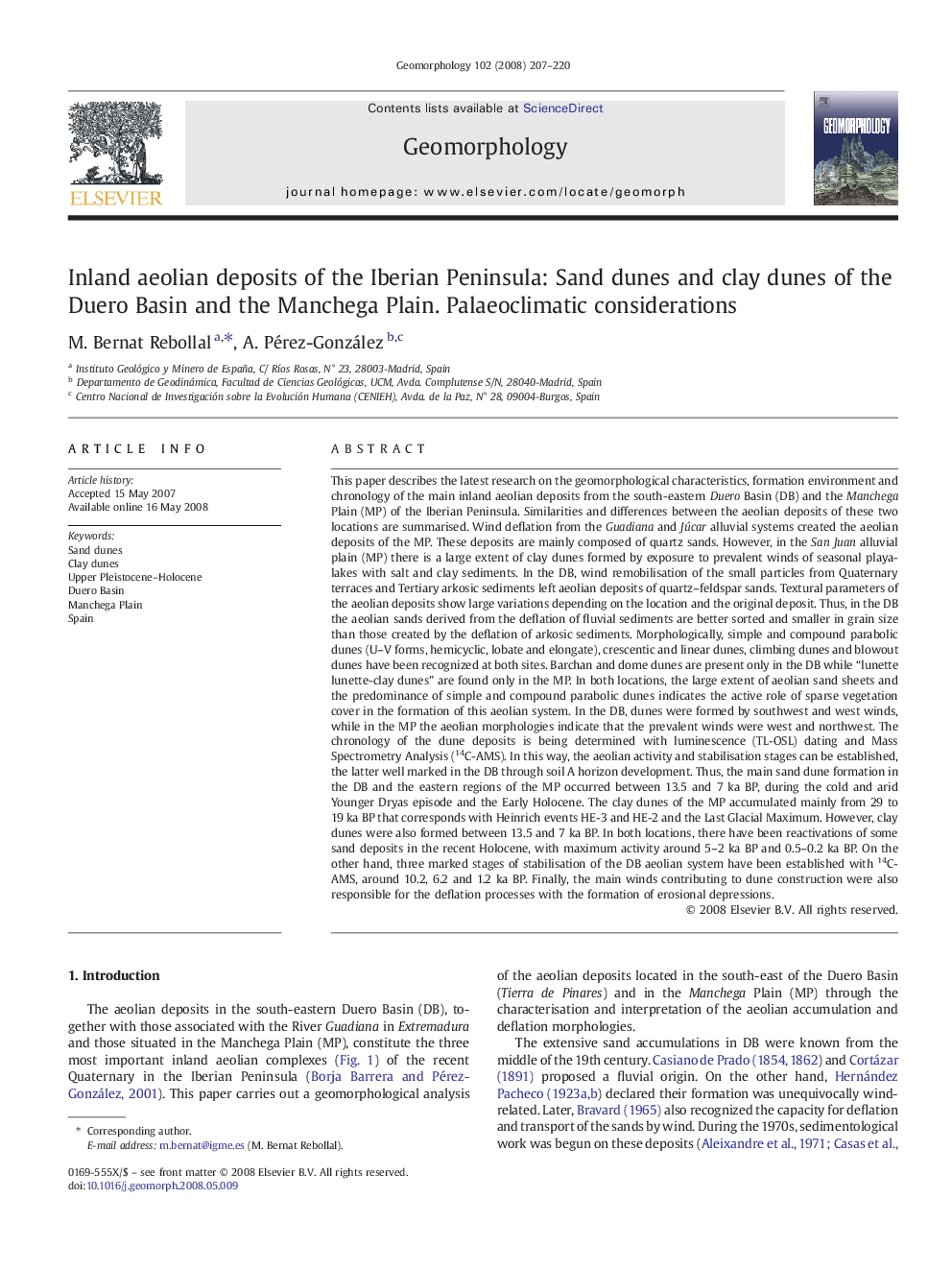| کد مقاله | کد نشریه | سال انتشار | مقاله انگلیسی | نسخه تمام متن |
|---|---|---|---|---|
| 4686640 | 1349559 | 2008 | 14 صفحه PDF | دانلود رایگان |
عنوان انگلیسی مقاله ISI
Inland aeolian deposits of the Iberian Peninsula: Sand dunes and clay dunes of the Duero Basin and the Manchega Plain. Palaeoclimatic considerations
دانلود مقاله + سفارش ترجمه
دانلود مقاله ISI انگلیسی
رایگان برای ایرانیان
موضوعات مرتبط
مهندسی و علوم پایه
علوم زمین و سیارات
فرآیندهای سطح زمین
پیش نمایش صفحه اول مقاله

چکیده انگلیسی
This paper describes the latest research on the geomorphological characteristics, formation environment and chronology of the main inland aeolian deposits from the south-eastern Duero Basin (DB) and the Manchega Plain (MP) of the Iberian Peninsula. Similarities and differences between the aeolian deposits of these two locations are summarised. Wind deflation from the Guadiana and Júcar alluvial systems created the aeolian deposits of the MP. These deposits are mainly composed of quartz sands. However, in the San Juan alluvial plain (MP) there is a large extent of clay dunes formed by exposure to prevalent winds of seasonal playa-lakes with salt and clay sediments. In the DB, wind remobilisation of the small particles from Quaternary terraces and Tertiary arkosic sediments left aeolian deposits of quartz-feldspar sands. Textural parameters of the aeolian deposits show large variations depending on the location and the original deposit. Thus, in the DB the aeolian sands derived from the deflation of fluvial sediments are better sorted and smaller in grain size than those created by the deflation of arkosic sediments. Morphologically, simple and compound parabolic dunes (U-V forms, hemicyclic, lobate and elongate), crescentic and linear dunes, climbing dunes and blowout dunes have been recognized at both sites. Barchan and dome dunes are present only in the DB while “lunette lunette-clay dunes” are found only in the MP. In both locations, the large extent of aeolian sand sheets and the predominance of simple and compound parabolic dunes indicates the active role of sparse vegetation cover in the formation of this aeolian system. In the DB, dunes were formed by southwest and west winds, while in the MP the aeolian morphologies indicate that the prevalent winds were west and northwest. The chronology of the dune deposits is being determined with luminescence (TL-OSL) dating and Mass Spectrometry Analysis (14C-AMS). In this way, the aeolian activity and stabilisation stages can be established, the latter well marked in the DB through soil A horizon development. Thus, the main sand dune formation in the DB and the eastern regions of the MP occurred between 13.5 and 7Â ka BP, during the cold and arid Younger Dryas episode and the Early Holocene. The clay dunes of the MP accumulated mainly from 29 to 19Â ka BP that corresponds with Heinrich events HE-3 and HE-2 and the Last Glacial Maximum. However, clay dunes were also formed between 13.5 and 7Â ka BP. In both locations, there have been reactivations of some sand deposits in the recent Holocene, with maximum activity around 5-2Â ka BP and 0.5-0.2Â ka BP. On the other hand, three marked stages of stabilisation of the DB aeolian system have been established with 14C-AMS, around 10.2, 6.2 and 1.2Â ka BP. Finally, the main winds contributing to dune construction were also responsible for the deflation processes with the formation of erosional depressions.
ناشر
Database: Elsevier - ScienceDirect (ساینس دایرکت)
Journal: Geomorphology - Volume 102, Issue 2, 1 December 2008, Pages 207-220
Journal: Geomorphology - Volume 102, Issue 2, 1 December 2008, Pages 207-220
نویسندگان
M. Bernat Rebollal, A. Pérez-González,